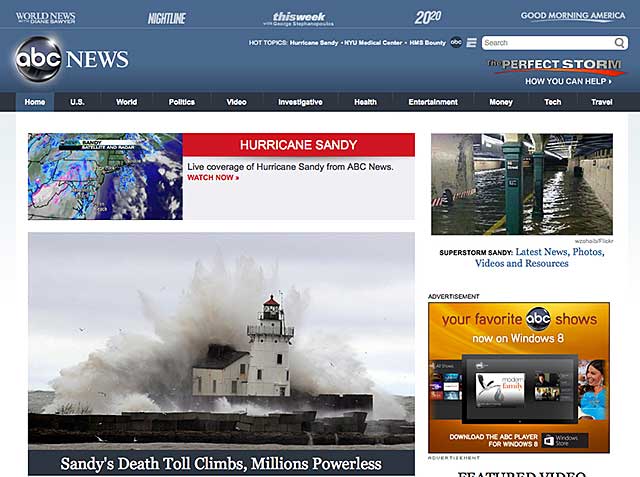Superstorm Sandy a Watershed for Online News Coverage
Record numbers of Americans turned to online video during Superstorm Sandy; both to provide and access real-time eyewitness reports from the storm-battered eastern seaboard.
"CNN's iReport had its highest traffic in our six-year history last Tuesday -- the day after Sandy made landfall," said Katie Hawkins-Gaar, senior producer and leader of CNN iReport. "This underscores what a big story the superstorm was, and what an incredibly important role user-generated content played in covering it."
"In our affected markets, mainly New York, Philadelphia, Washington D.C., and Boston, web traffic was running close to 10 times normal during the 72-hour peak storm period," noted Hawkins-Gaar.
CNN wasn't the only news channel to see a traffic boost. "We saw several stations experience record growth in terms of various metrics -- page views, visits, streams -- both desktop and mobile," said Ron Stitt; vice president of digital media and internet operations with Fox.
"End-user consumption of video showed a tremendous spike," Stitt added. "Live streaming news coverage and weather radars were very popular, along with multiple press conferences. Stations did close to one million live streams over the course of the storm."
The Power of Online Newsgathering Grows
The combination of high resolution cellphone cameras, web-literate viewers with access to wireless internet, and news organizations interacting with social media sites such as Facebook, Instagram, Tumbler, and Twitter has proven to be a potent newsgathering tool during past disasters. But Superstorm Sandy took the net's usefulness to new heights, both in directing stirring visuals to news organizations and serving that content to eager viewers.
"It is a barometer that shows developments in real-time," said Ryan Osborn, vice president of digital innovation at NBC News. "Whether seeing photos of devastation in Breezy Point or tweets from Con Edison about power updates or even trends like people going to great lengths to charge their devices, those are all things that producers gathered information online and then reported them out."
The fact that the superstorm took place in the heavily-populated New York City area is one reason that the online audience was so huge. Another is that this region is well-served by both wired and wireless internet access, and the people who live there are well-connected through a range of devices.
Mindful of this fact, news organizations took steps to exploit online news coverage as best they could. They were aided by Superstorm Sandy occurring in the run-up to the U.S. national elections, when the networks had all deployed substantial newsgathering resources.

"ABC News already had a number of online newsgathering/distribution tools in place for election night, including apps for iPhone and Android," said Lea Ann Leming, executive producer for ABC News Digital. "When Superstorm Sandy hit, we were able to use these resources to stream multiple pressers live at one time."
Unmatched Content...and Support
The fact that viewers have access to high resolution cameras and web access resulted in a wealth of on-the-scene content that no news teams could hope to match.
"Whether it was floating cars, homes being destroyed, or people dealing with the pain of great loss, the video and photos viewers posted were stunning in their immediacy," Leming said. "People going through Superstorm Sandy in person were able to share it with us and the world, and they did thanks to online media."
It wasn't just scenes of destruction: Online video provided a great way for people in the storm's path to share their experiences in real-time. This was certainly true for HuffPost Live, since the website's New York City studios at 777 Broadway were dead to a blackout.
"We had no power and no heat," said John Pavley, HuffPost Live's chief technical officer. "Thankfully, our use of Google Hangouts and video messaging allowed people in the tri-state area to file live reports to our site as Superstorm Sandy unfolded, while our distributed production and CDN facilities meant that we stayed online despite the blackout."
The web even saved NY1's "The Call," which relies on viewer phone calls for news content. Due to the storm, telephone circuits were down in New York City, leaving show host John Schlomo with no one local to talk to.
"We were getting a few calls from out of state, from people who were watching us online," Schlomo explained. "But with the phones down, it was up to Facebook and Twitter to connect us with our viewers at a time when they really needed us."
User-Generated Content Changing the Nature of News...and Politics
All the sources interviewed for this article agree that online content has become central to their newsgathering processes.
"Big news events are now invariably multiplatform efforts for us, and user-generated content and information from social networks is a big part of that," said Fox's Stitt.
But user-generated content isn't just bolstering what's being aired and streamed: It is affecting what constitutes news, and influencing decisions made by news directors and politicians.
"The NY Marathon go/no-go debate is a great example of the impact of social media on traditional coverage, and ultimately, impacting political reality and decision-making," Stitt said. "WNYW received a lot of Facebook comments on this, including one from a mother in Staten Island who was worried about survival, and expressing not so much indignation as disbelief that the city could even be thinking of diverting resources while she was in the dark, with no food or water, with her children."
Online News Coverage Has Arrived
Record numbers for live streaming and web site traffic, news organizations and politicians taking their cues from social media, and viewer-sourced visuals that tore down the wall between the watcher and the watched: These are all the legacies of Superstorm Sandy's online news coverage.
It seems reasonable to say that online news coverage has truly arrived. The sheer volume of content and web traffic generated by Superstorm Sandy proves this without room for doubt.
Hurricane image via Shutterstock.
Companies and Suppliers Mentioned